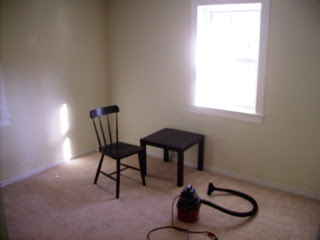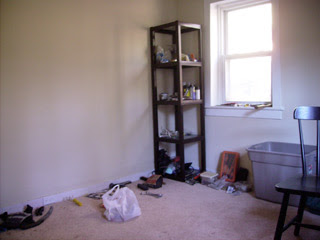
The dining room, after clearing most of the stuff away
Many houses have a room that serves as a clutter magnet. The room’s original purpose, whatever it was, has been buried under all the stuff that no one knows what to do with. Whatever people have, if they don’t know where to put it, this room is where it is most likely to end up. Most often, the room in question is the dining room.
And that’s what it was in my house. From the day I moved in, the dining room was just a place to plop things down. I did not even own a dining table, so the idea of using the dining room for dining seemed remote. Still, I didn’t like the idea of a room just filled with miscellaneous stuff. I was sure I would want to use the room for something, so I decided to clear it all out.

The dining room, easy to clean while empty
The writing desk went in a corner of my bedroom. The shipping supplies, on a table in the basement. The cameras, in a cabinet upstairs. The office supplies, in the office, or in a box in the basement. And so on. By the time I had figured out the right place to put everything, I had a completely empty room.
If you are used to cleaning around clutter, you may be amazed how quickly you can clean a room that’s empty. It took weeks to get everything out of the dining room and organize it in the other rooms of the house. Cleaning the empty room took 15 minutes. As Don Aslett has pointed out, most of the time you spend cleaning a room is spent maneuvering around the furniture and moving things to clean under them and behind them. When a room is empty, you’re just cleaning, and it goes quickly.

Using the empty space to organize the tools
I don’t yet have a specific plan for the dining room. In the meantime, it hasn’t been any trouble at all to find ways to use the space. One of my long-neglected projects is to organize my tools and hardware, and that’s become easy to do with this much space to collect them and sort them out. The tools look a lot smaller now that they’re grouped into categories. I’ll be storing them away accordingly, in several smaller boxes, where, for the first time, they will all be easy for me to find. After that project is done, I’m sure I will have something else I can do with the same space.
Space is valuable, and there are two ways to prove that that’s true: by the money you pay for the space, and by the things you accomplish when you have the space to do them. If you have a room that has become a clutter magnet, you might do what I did: empty it out, and then see what valuable things you can do in that space.


No comments:
Post a Comment